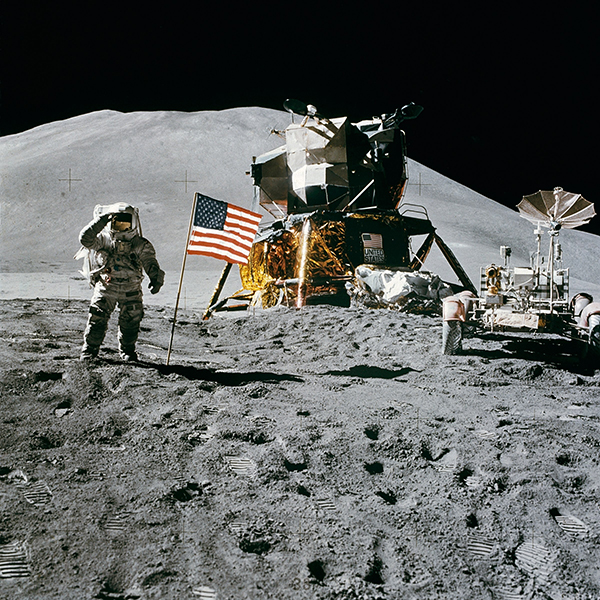 The total weight of the ship together with the rocket at the time of takeoff from Earth was 3,200 tons and its total height was 110 meters. The ship is made up of three Modules, Command Module, Service Module and Lunar Module. The Command Module is the one formed by the Command and Service Modules. The Lunar Module is made up of two Phases, Ascent and Descent.
The total weight of the ship together with the rocket at the time of takeoff from Earth was 3,200 tons and its total height was 110 meters. The ship is made up of three Modules, Command Module, Service Module and Lunar Module. The Command Module is the one formed by the Command and Service Modules. The Lunar Module is made up of two Phases, Ascent and Descent.
Only the Lunar Module landed on the Moon, taking off again for the Ascent Phase, while the Descent Phase remained on the Moon. The Command Module remained in lunar orbit throughout the Lunar Module's stay on the Moon. The Lunar Module weighs 15 tons and the Command Module 25 tons, therefore the overall weight of the three Modules is 40 tons. The Service Module has 1 motor and the Lunar Module has 2 motors, one in each phase.
 The Saturn V rocket is made up of three Phases; The first Phase has 5 engines with a ignition duration of 2 minutes and 30 seconds, consuming 2,050 m3 of fuel; The second Phase has 5 engines with a ignition duration of 6 minutes and 30 seconds, consuming 1,350 m3 of fuel; The third phase consists of 1 engine and ignition duration of 2 minutes, consuming 39 tons of fuel.
The Saturn V rocket is made up of three Phases; The first Phase has 5 engines with a ignition duration of 2 minutes and 30 seconds, consuming 2,050 m3 of fuel; The second Phase has 5 engines with a ignition duration of 6 minutes and 30 seconds, consuming 1,350 m3 of fuel; The third phase consists of 1 engine and ignition duration of 2 minutes, consuming 39 tons of fuel.
The first phase consumes 13.5 m3 of fuel per second. Orbit entry time is 11 minutes and 40 seconds. The third phase is restarted to leave Earth's orbit. It leaves lunar orbit with the Service Module engine.
Summary of the trip to the Moon
The launch took place on 16/07/1969, from the Cape Kennedy space base (Florida) and the moon landing was on July 20 in the "Sea of Tranquility", the outbound trip lasting 4 days, 6 hours and 46 minutes.
 The lunar walk was carried out on July 21, 1969, with Neil Armstrong being the first to leave the lunar surface and then Edwin Aldrin, with the duration of the walks being 2 hours and 11 minutes for Armstrong and 1 hour and 32 minutes for Aldrin.
The lunar walk was carried out on July 21, 1969, with Neil Armstrong being the first to leave the lunar surface and then Edwin Aldrin, with the duration of the walks being 2 hours and 11 minutes for Armstrong and 1 hour and 32 minutes for Aldrin.
While this was happening Michael Collins was waiting for his two companions in lunar orbit in the Command Module. The takeoff of the Moon took place on July 21, 1969, with the duration of the stay on the Moon being 21 hours and 36 minutes, and the landing took place on July 24, 1969 in the Pacific Ocean, with the duration of the return trip of 2 days, 22 hours and 56 minutes.
The total duration of the trip was 8 days, 3 hours and 18 minutes.

